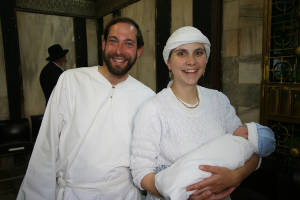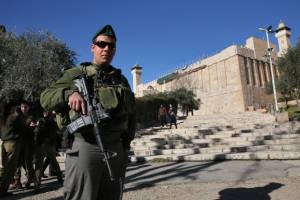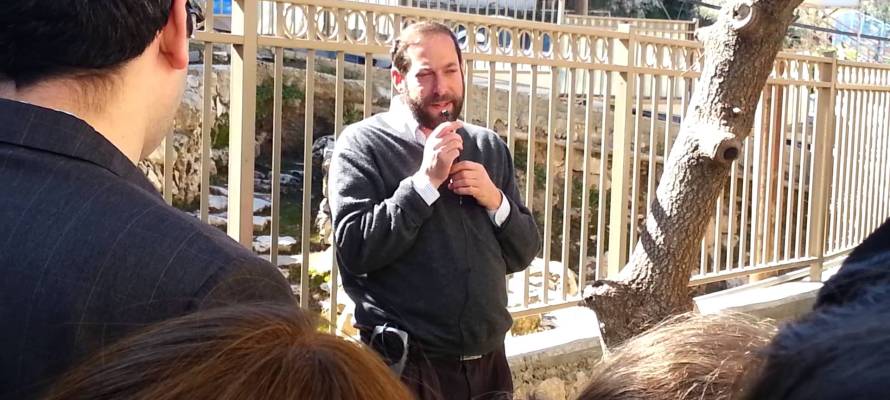
“We see ourselves not as individuals, but on a mission connecting young people to their Jewish roots,” says Rabbi Simcha Hochbaum, who, as director of tourism for The Hebron Fund, educates the public about the significance of the Jewish city of Hebron.
Rabbi Simcha Hochbaum, a native of Staten Island, NY, and his wife Leah, a Montrealer, have been living in Hebron for the past two decades, hosting individuals, families and groups and educating them about the Jewish historical significance of the holy city as well as the political situation.
A graduate of Yeshiva University’s Azrieli Graduate School of Jewish Education, Rabbi Hochbaum, who also holds a number of teaching positions in post-high school Jewish educational institutions, has been working for The Hebron Fund, leading tours in Hebron, Jerusalem, since his arrival in 1995. Leah, an occupational therapist with a degree from New York University, has been working for several years with handicapped children; she currently practices in Gush Etzion. They have six children, ranging in age from five to 22.
Hebron is the second-holiest city in Judaism, second to Jerusalem. Rich in biblical Jewish history, it is where Abraham bought the Cave of the Patriarchs and Matriarchs, where all except for Rachel are buried. King David established his kingdom in Hebron and reigned there for seven years before moving the Jewish capital to Jerusalem.
There was a continuous Jewish presence in the city throughout the Byzantine, Arab, Mameluke, and Ottoman periods until the massacre in 1929, when the local Arabs murdered 67 Jews; scores were tortured and maimed. For many years, the small Jewish community had been living peacefully with their Arab neighbors. The few hundred surviving Jews were relocated to Jerusalem, and it was the first time in hundreds of years that the ancient Jewish city was empty of Jews. After the 1967 Six Day War, under the leadership of Rabbi Moshe and Miriam Levinger, Jews re-established a presence in Hebron.

Rabbi Simcha and Leah Hochbaum at the brit milah (circumcision) of one of their sons. (hebron.com)
Today, 1,000 Jews reside in biblical Hebron, including 90 families and 240 yeshiva students.
Hebron is a divided city, with 80 percent allotted to the Arabs and 20% to the Jews. As Hochbaum explains, within that 20%, only three percent includes civilian residents; the rest has an Israeli military presence. Also, 15,000 Arabs live in that area. In greater Hebron, there are more than 100,000 Arabs, who, in general, are militant and fundamentalist. On the whole, they identify with the Hamas terror organization, which won eight out of eight seats in Hebron in the most recent Palestinian elections.
The Hochbaums moved directly to Hebron from New York in 1995. “After the [signing of the] Oslo Accords [in 1995, aimed at achieving a peace agreement between Israel and the Palestinian Authority], we realized it would only lead to more bloodshed. We decided to take a year off and connect with one of these communities [in Judea and Samaria]. At the same time, we felt the calling of not standing idly by when Jewish blood is being spilled…. That year became 20 [years],” Rabbi Hochbaum explained in conversation with United with Israel (UWI).
He leads at least four tours a week. Those open to the public take place every Wednesday, and three times a week during the busy seasons. The tours attract visitors of diverse religious and ethnic backgrounds from all over the world, including, for example, North American, China, the Philippines and Africa.

An Israeli soldier stands guard outside the Cave of the Patriarchs in Hebron. (Nati Shohat/Flash90)
“We offer a day of spiritual connection and a deep understanding of the political situation of the Jewish community in Hebron today,” he said. “When I began as director of tourism, it was difficult to fill one van a week. Since then, over 700,000 have come to visit Hebron.”
Visitors to Hebron over Shabbat are amazed by the continuous warmth and hospitality shown by the Hochbaums and the local community in general. “Shabbat is a 26-hour tour,” he quipped. Each week, “without exception, we are privileged to have guests for Shabbat, whether students, summer programs or others. Our home is a bit of a haven for people seeking the full experience of Hebron. Definitely there are moments that are challenging, and vacations are rare, but at the same time we see ourselves not as individuals, but on a mission connecting young people to their Jewish roots.”
Not Watching, but Making Jewish History
United with Israel asked Rabbi Hochbaum about the safety and emotional well-being of the children growing up in Hebron, surrounded by hostile Arabs.
“Despite all sociological studies, the children grow up with tremendous pride, not just watching Jewish history, but helping to make Jewish history,” he stated. “Our children feel no fear in terms of walking freely between Jewish communities, playing outside. They participate in activities such as ceramics, self-defense and basketball. Of course we owe gratitude to the Israeli government for providing security. The soldiers here protect the Jewish community, allowing us to live a normal day-to-day life.”
The Jewish residents of Hebron have a strong bond with the IDF soldiers stationed there, he stressed. “Part of living here is integrating with the soldiers, showing gratitude, children keeping them company, coffee houses open round the clock providing food and drink.”
By Atara Beck, senior writer, United with Israel
(For information on The Hebron Fund, visit https://hebronfund.org/)










